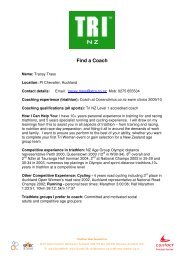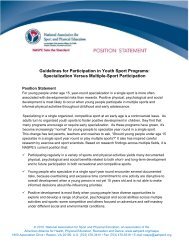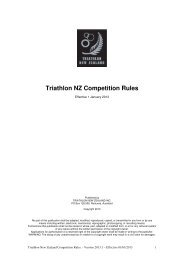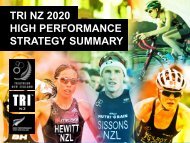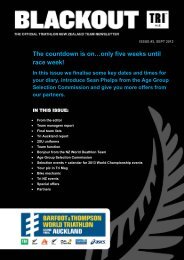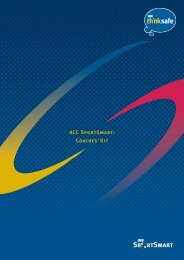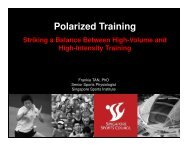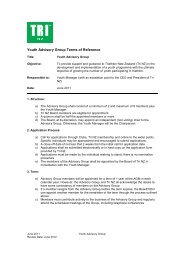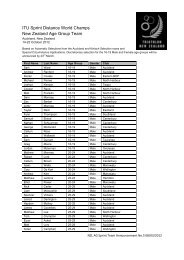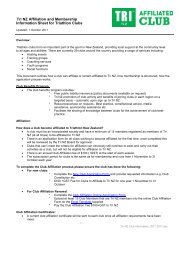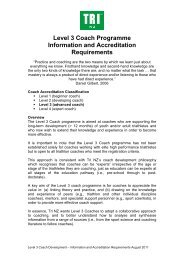The Science of Cycling - IngentaConnect
The Science of Cycling - IngentaConnect
The Science of Cycling - IngentaConnect
Create successful ePaper yourself
Turn your PDF publications into a flip-book with our unique Google optimized e-Paper software.
<strong>The</strong> <strong>Science</strong> <strong>of</strong> <strong>Cycling</strong>: Part 1 293<br />
Table V. Absolute and relative power output values at the individual lactate threshold (mean ± SD) [reproduced from Padilla et al., [38] with<br />
permission]<br />
Variable Flat terrain Time trialist All terrain Uphill<br />
W LT (W) 356 ± 31 357 ± 41 322 ± 43 308 ± 46<br />
W LT (W/kg) 4.67 ± 0.25 5.0 ± 0.2 4.73 ± 0.48 4.91 ± 0.5<br />
W LT (W/kg –0.32 ) 89.0 ± 6.7 91.0 ± 8.0 83.4 ± 10.0 81.0 ± 10.8<br />
W LT (W/kg –0.79 ) 11.6 ± 0.69 12.25 ± 0.64 11.47 ± 1.23 11.71 ± 1.29<br />
W LT (W/m –2 FA) 962.5 ± 59.0 1009.7 ± 65.0 933.7 ± 110.2 940.7 ± 10.3<br />
W LT (%W max) 77 ± 2.0 78 ± 3.0 74 ± 7.0 76 ± 3.0<br />
FA = frontal area; W LT = power output at lactate threshold; W max = maximal power output.<br />
cycle trial. <strong>The</strong>se investigators concluded that Wmax required to achieve this characteristic is unknown.<br />
may be a good parameter for assessment <strong>of</strong> cycling Nonetheless, pr<strong>of</strong>essional riders generally cycle<br />
performance. Test data reveal that Wpeak measured ~35 000 km/year and compete ~90 days. [24]<br />
during a maximal incremental cycle test can be used This training volume impacts the cyclist’s effias<br />
a predictor <strong>of</strong> performance in endurance cy- ciency. <strong>The</strong> pr<strong>of</strong>essional cyclist’s efficiency during<br />
clists. [16,49] A power/weight ratio <strong>of</strong> >5.5 W/kg is heavy exercise appears to be positively related to the<br />
considered a necessary prerequisite for top-level percentage <strong>of</strong> type I fibres in the vastus lateralis<br />
competitive cyclists. [55] However, this criterion must muscle. [57] A higher proportion <strong>of</strong> type I fibres in the<br />
used with caution as the protocol used during testing muscle is associated with a lower submaximal oxycan<br />
affect the outcome <strong>of</strong> power output, thus further gen cost, thus a greater gross efficiency. [58] This<br />
reinforcing the need for a common protocol. efficiency is a reflection <strong>of</strong> the increase in aerobic<br />
metabolism and related increases in muscle power<br />
4.1.3 Efficiency<br />
output.<br />
Recent information indicates that in pr<strong>of</strong>essional<br />
[34]<br />
cyclists the rate <strong>of</strong> the ˙VO2 rise, elicited by graded 4.1.4 Breathing Pattern<br />
exercise, decreases at moderate to high work-loads <strong>The</strong> cyclist’s breathing pattern appears to have<br />
to the maximal attainable power output. [24] More some influence on performance. Pr<strong>of</strong>essional riders<br />
importantly, these authors observed that mechanical exhibit a unique breathing pattern at high workefficiency<br />
seemed to increase with rising exercise loads characterised by a lack <strong>of</strong> tachypnoeic shift,<br />
intensity. <strong>The</strong>se findings reveal that pr<strong>of</strong>essional that is they continue to increase VE through increasroad<br />
cyclists acquire a high cycling efficiency al- ing tidal volume versus breathe frequency. [59] It is<br />
lowing them to sustain extremely high work-loads suggested that this breathing adaptation may enfor<br />
extended periods <strong>of</strong> time. To that end, pr<strong>of</strong>es- hance the efficiency and metabolic cost <strong>of</strong> breathing<br />
sional racers exhibit considerable resistance to fa- and partly account for the ˙VO 2 kinetics exhibited by<br />
tigue <strong>of</strong> recruited motor units at high submaximal pr<strong>of</strong>essional cyclists. Nevertheless, the oxygen cost<br />
intensities. [46,56] <strong>The</strong> years <strong>of</strong> training and mileage <strong>of</strong> breathing in highly fit individuals has been esti-<br />
Table VI. Absolute and relative power output values at the onset <strong>of</strong> blood lactate accumulation (WOBLA) [mean ± SD; reproduced from<br />
Padilla et al., [38] with permission]<br />
Variable Flat terrain Time trialists All terrain Uphill<br />
W OBLA (W) 417 ± 45.0 409 ± 46.0 366 ± 38.0 356 ± 41.0<br />
W OBLA (W/kg) 5.46 ± 0.42 5.73 ± 0.21 5.37 ± 0.37 5.70 ± 0.46<br />
WOBLA (W/kg –0.32 ) 104.1 ± 10.3 104 ± 8.9 94.8 ± 8.7 94.8 ± 9.6<br />
W OBLA (W/kg –0.79 ) 13.57 ± 1.10 14.03 ± 0.69 13.01 ± 0.99 13.57 ± 1.14<br />
W OBLA (W/m –2 FA) 1125.8 ± 100.3 1156.8 ± 70.0 1061.0 ± 91.0 1090.4 ± 88.0<br />
W OBLA (%Wmax) 90 ± 3.0 89 ± 2.0 84 ± 5.0 88.5 ± 5.0<br />
FA = frontal area; Wmax = maximal power output.<br />
© 2005 Adis Data Information BV. All rights reserved. Sports Med 2005; 35 (4)



